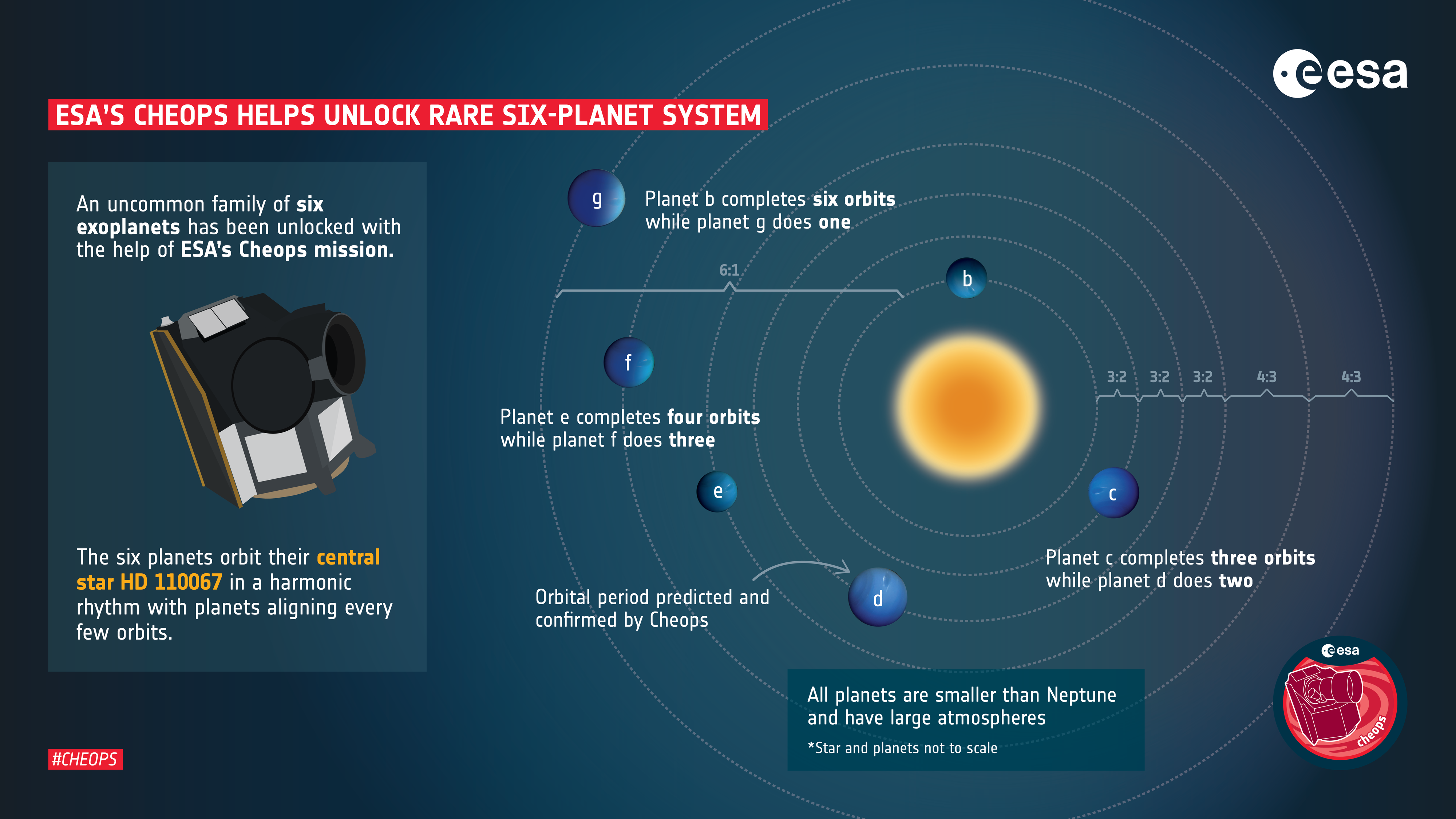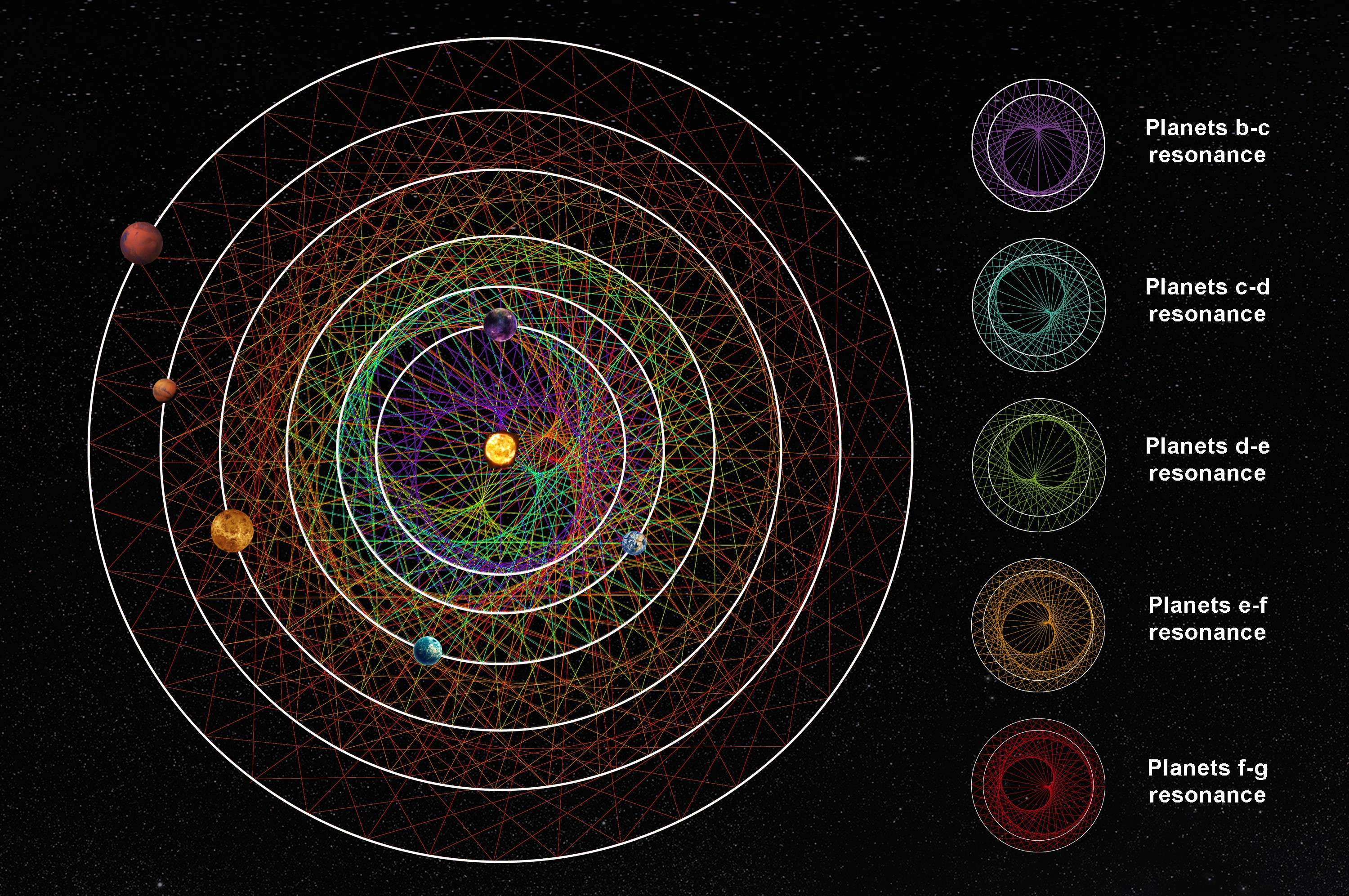This rare exoplanet system has 6 'sub-Neptunes' with mathematically perfect orbits
"I could even hear through my headphones the gasp in the room when there were no microphones around. You could see that it was a very nice discovery."

Astronomers have discovered an uncommon star system located just 100 light-years away from us, with six planets huddled immensely close to their host star — so close, in fact, that all their orbits could fit within the distance between Mercury and our sun. Puzzlingly, unlike our own solar system, it appears this newfound slice of the cosmos has remained largely unchanged since its birth over a billion years ago.
"If the galaxy was the Empire State Building, we can only see and detect the planets next to stars that have apartments on our floor," study co-author Enric Palle of the Instituto de Astrofísica de Canarias told reporters during a press briefing. "We just discovered our neighbor."
100 light-years may sound like quite a distance, but cosmically speaking, the system is incredibly close to us. Designated HD 110067, it sits in the constellation Coma Berenices, near Virgo in the northern sky.
And because the six planets in HD 10067 are so cozy with their fairly bright and orange star, none of them lie in the habitable zone, the region around a star with the right conditions to support life as we know it. The planets also orbit very quickly, such that their "years" range from 9 days to 55 days.
Related: Europe's planet-hunting CHEOPS telescope spies its 1st alien worlds
To-scale animation of the orbits of the six newfound planets in the HD110067 system about 100 light-years from Earth. The pitch of the notes played when each planet transits matches the resonant change in orbital frequencies between each subsequent planet.
(Video credit: Animation, composition and annotations by Dr. Hugh Osborn (University of Bern), background image by NASA/MIT/TESS and Ethan Kruse)
Get the Space.com Newsletter
Breaking space news, the latest updates on rocket launches, skywatching events and more!
Initially detected in 2020 by NASA's Transiting Exoplanet Survey Satellite (TESS), astronomers realized early on that they were dealing with at least two so-called sub-Neptunes, which are planets about two to three times as big as Earth and blanketed by apparently puffy atmospheres. The northern sky was to disappear below the horizon soon after TESS' detection, meaning the team only had a month or so to confirm the discovery using ground-based telescopes, said study co-author Rafael Luque of the University of Chicago.
Then, with new data from TESS, collected when it revisited the same patch of sky two years later, plus an "orchestrated campaign" targeted at the star for more detailed observations by the European Space Agency's Characterising Exoplanet Satellite (Cheops), scientists confirmed a third exoplanet in the system.

The remaining three outer planets have been attributed to unmatched dips of starlight in TESS data, known to be caused by orbiting planets, thanks to the orbits of all three confirmed planets existing nearly perfectly in what scientists call resonance. That is, the first planet makes three orbits for every two of the second planet. The exact same dynamics play out between the next two planets. The fourth planet is computed to make four orbits for every three of the fifth planet, which, in turn, makes four orbits around the star for every three of the outermost planet.
In our own solar system, Pluto is in a similar resonance with Neptune (it circles our sun twice for every three orbits of Neptune).
"This system will help us answer questions without needing to comb through all the different exoplanet systems out there," Keighley Rockcliffe, a graduate student studying exoplanet atmospheres at Dartmouth College in New Hampshire and who was not involved with the new research, told Space.com. Because the six planets are orbiting the same star and do not seem to have changed their locations since formation, astronomers can use just this one system to better understand planetary system formation and evolution processes by comparing various parameters of the six planets, including their compositions, Rockcliffe said.

"It's like how studying a plant — maybe a flower's petal colors — can tell us about the soil it grew from," she said. "So, HD 110067 has a lot of really exciting things going for it!"
Luque, the first to have been notified of the confirmation of the outer planets by colleagues at NASA Ames Research Center, recalled sharing the news with the rest of the team via a conference call.
"I could even hear through my headphones the gasp in the room when there were no microphones around," he said. "You could see that it was a very nice discovery."
This perfectly resonant system with its long chain of planets is a rare find. It is something "we learn in school but we don't really think they have an application to nature," said study co-author Hugh Osborn of the University of Bern, who recalled being "shocked and delighted" when he first learned of the discovery. "Often, we make predictions, and nature finds a way to do something else to not quite match what we expect."
Planets start off in resonance when they're born from dusty protoplanetary disks, but those delicate orbits tend to get thrown off balance due to outsider stars passing by or dominating planets, larger than others within the system, treading too close. This has occurred within our solar system too, but HD 110067, it appears, remained impressively sturdy during any such interruptions.
"We'd used mathematical theory to predict these orbits and nature really did match these beautiful, perfect fractions," said Osborn. "That was a wonderful moment."
Studying the planets could even shed light on why many solar systems, including our own, lack a sub-Neptune, despite this type of planet being the most common type in the Milky Way. In our corner of the cosmos, Jupiter is thought to have played a decisive role in shaping early evolution of our system and its planets, possibly gobbling up all available material such that a planet the size of a sub-Neptune did not stand a chance to coalesce.
So, the newfound planetary system is "a golden target" for further study as it looks the way most systems would when the planet-forming protoplanetary disk dissipates, said study co-author Adrien Leleu of the University of Geneva.
In the coming months, the team plans to measure the masses of the planets, which would offer insight into the system's chemical makeup. Then, it may be possible to sort of "reverse engineer" the evolution of these planets to better understand their formation mechanisms, scientists shared during the press briefing.
This research is described in a paper published Wednesday (Nov. 29) in the journal Nature.
Join our Space Forums to keep talking space on the latest missions, night sky and more! And if you have a news tip, correction or comment, let us know at: community@space.com.

Sharmila Kuthunur is a Seattle-based science journalist focusing on astronomy and space exploration. Her work has also appeared in Scientific American, Astronomy and Live Science, among other publications. She has earned a master's degree in journalism from Northeastern University in Boston. Follow her on BlueSky @skuthunur.bsky.social









